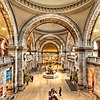
Abraham Bloemaert was a Dutch painter and printmaker in etching and engraving. He was initially working in the style of the "Haarlem Mannerists", but in the 16th century altered his style in line with the new Baroque style that was then developing. He mostly painted history subjects and some landscapes. He was an important teacher, who trained most of the Utrecht Caravaggisti, at least for a period.

Gerard van Honthorst was a Dutch Golden Age painter who became known for his depiction of artificially lit scenes, eventually receiving the nickname Gherardo delle Notti. Early in his career he visited Rome, where he had great success painting in a style influenced by Caravaggio. Following his return to the Netherlands he became a leading portrait painter.

Andries Both, was a Dutch genre painter. He was part of the group of Dutch and Flemish genre painters active in Rome in the 17th century known as the bamboccianti, who painted scenes from the everyday life of the lower classes in Rome and its countryside.

Utrecht Caravaggism refers to the work of a group of artists who were from, or had studied in, the Dutch city of Utrecht, and during their stay in Rome during the early seventeenth century had become distinctly influenced by the art of Caravaggio. Upon their return to the Dutch Republic, they worked in a so-called Caravaggist style, which in turn influenced an earlier generation of local artists as well as artists in Flanders. The key figures in the movement were Hendrick ter Brugghen, Gerrit van Honthorst and Dirck van Baburen, who introduced Caravaggism into Utrecht painting around 1620. After 1630 the artists moved in other directions and the movement petered out. The Utrecht Caravaggisti painted predominantly history scenes and genre scenes executed in a realist style.

Joachim Anthoniszoon Wtewael was a Dutch Mannerist painter and draughtsman, as well as a highly successful flax merchant, and town councillor of Utrecht. Wtewael was one of the leading Dutch exponents of Northern Mannerism, and his distinctive and attractive style remained largely untouched by the naturalistic developments happening around him, "characterized by masterfully drawn, highly polished figures often set in capricious poses". Wtewael was trained in the style of late 16th-century Haarlem Mannerism and remained essentially faithful to it, despite painting well into the early period of Dutch Golden Age painting.

Cornelis van Poelenburgh or Cornelis van Poelenburch, was a Dutch landscape painter and draughtsman. He was the leading representative of the first generation of Dutch landscape painters who were active in Rome in the early 17th century. He was known for small-scale paintings depicting Italianate landscapes with small figures enacting biblical or mythological scenes or in contemporary attire.

Self Portrait is an oil on canvas painting by the Dutch artist Rembrandt. Painted in 1652, it is one of over 40 painted self-portraits by Rembrandt, and was the first he had painted since 1645. In composition it is different from his previous self-portraits, depicting the painter in a direct frontal pose, hands on his hips, and with an air of self-confidence. It was painted the year that his financial difficulties began, and breaks with the sumptuous finery he had worn in previous self-portraits. Art historian Christopher White has called it "one of the most magisterial and sombre of these (late) pictures". It is in the Kunsthistorisches Museum in Vienna.
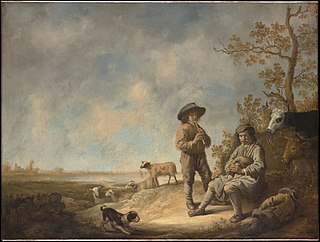
Piping Shepherds is a mid-17th century painting by Dutch artist Aelbert Cuyp. Done in oil on canvas, the painting depicts a pair of shepherds playing a tune on their pipes as their flock idles nearby. The work is currently in the collection of the Metropolitan Museum of Art.

A Musician and His Daughter is an early 17th century painting by Dutch portraitist Thomas de Keyser. Done in oil on wood panel, the painting depicts a father and his daughter in their contemporaneously stylish home. The painting is currently in the collection of the Metropolitan Museum of Art.

In a Courtyard, Tangier is a late 19th-century painting by French artist Philippe Pavy. Done in oil on wood, the work depicts a young woman resting in a Tangerian courtyard. The painting was one of a series of paintings Pavy produced after he traveled in North Africa in the 1880s. It is currently in the collection of the Metropolitan Museum of Art.

The Farm at Les Collettes, Cagnes is an early 20th century oil on canvas painting by French artist Pierre-Auguste Renoir. The work is in the collection of the Metropolitan Museum of Art.

Lady at the Tea Table is a late 19th-century painting by American artist Mary Cassatt. The work, done in oil on canvas, is in the collection of the Metropolitan Museum of Art.

Ferry near Gorinchem is a mid 17th century painting by Dutch artist Salomon van Ruysdael. Done in oil on canvas, the work depicts a riverside embankment near Gorinchem in the Netherlands; in addition, the painting also depicts the prominent St Jan's Tower of the Grote Kerk, the town's church. Ruysdael's rendering of the land near Gorinchem was possibly impacted due to the artist's owning of a mill on the river. The work is in the collection of the Metropolitan Museum of Art.
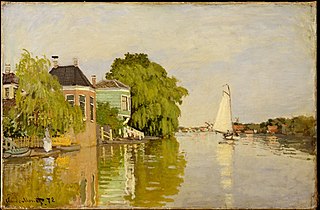
Houses on the Achterzaan is an 1871 painting by French artist Claude Monet. Done in oil on canvas, the work depicts riverside garden houses on the west shore of the Achterzaan river in Zaandam, the Netherlands. He painted it from the dam in the Zaan, facing northwest. The painting is in the collection of the Metropolitan Museum of Art.

Cypresses is a late 19th-century painting by Dutch artist Vincent van Gogh painted around June 1889. Done in oil on canvas, the painting depicts a pair of cypress trees in the French countryside. The work is currently on display in the Metropolitan Museum of Art.

A Woman Playing the Theorbo-Lute and a Cavalier is a mid 17th century painting by Dutch artist Gerard ter Borch the Younger. Done in oil on wood, the work depicts a young woman playing a theorbo while her lover looks on. The painting is in the collection of the Metropolitan Museum of Art.
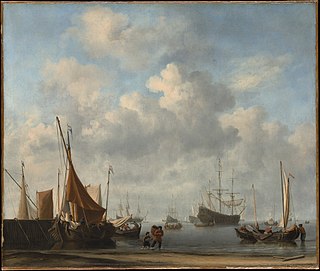
Entrance to a Dutch Port is a mid 17th century painting by Dutch artist Willem van de Velde the Younger. Done in oil on canvas, the painting depicts a bustling harbor in the Netherlands. The work is indicative of the historical mercantile power of the Netherlands during the 17th century. Entrance to a Dutch Port is in the collection of the Metropolitan Museum of Art.

Morning, An Overcast Day, Rouen is a late 19th-century painting by Danish-French artist Camille Pissarro. Done in oil on canvas, the work depicts the industrial cityscape of Rouen, France. The centerpiece of the painting is Boieldieu Bridge, a steel arch bridge which Pissarro painted from his room in a nearby hotel. The painting is in the collection of the Metropolitan Museum of Art.
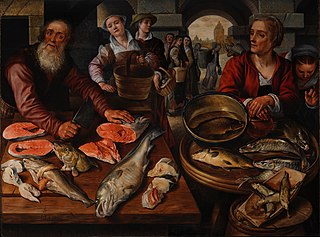
Fish Market is a mid 16th century painting by Dutch artist Joachim Beuckelaer. Done in oil on wood, the work depicts a bustling fish market. Painting during the waning years of the Beeldenstorm, the painting reflects the changing subject of Dutch art from religious to secular themes. The work is currently in the collection of the Metropolitan Museum of Art.

Lobster Fishermen is an early 20th century painting by American artist Marsden Hartley. Done in oil on masonite, the work depicts a group of lobster fishermen in Hartley's native state of Maine. Considered part of Hartley's 'Maine Series', Lobster Fishermen is in the collection of the Metropolitan Museum of Art.





















